Most Important OBG PYQs for FMGE
Apr 28, 2025

PYQs are your golden weapon to master OBGYN questions in the FMGE July 2025 exam.
With a weightage of 30 marks in the FMG exam, Obstetrics and Gynaecology is one of the most important subjects you need to study.
A thorough revision of the PYQs, for OBGYN and other subjects, can easily land you in the 150+ marks category. In general, PYQs are important for all exams, but they are critical while preparing for FMGE.
PYQs are extensively asked in the FMG exam. Covering all the PYQs from the past 5 years can help you cover almost 50% of the entire syllabus.
Moreover, PYQs offer valuable insights into the exam pattern, question style and frequently asked topics.
Therefore, if you want to master the OBGYN syllabus for the FMGE July exam, go through the following questions in detail.
Once you identify the recurring themes and topics, you can easily solve similar questions in the FMGE exam. This is because the topics remain the same. Only the perspective of asking the question changes.
In this blog, we shall go through the most important 5-year PYQs for Obstetrics and Gynaecology for your FMGE preparation.
Let’s begin.
Q. Which of the following is an absolute contraindication to IUCD insertion.
a. Unexplained vaginal bleeding
b. History of previous PID
c. Previous ectopic pregnancy
d. HIV positive status
Answer: Unexplained vaginal bleeding
Q. All the following regarding 'Non scalpel vasectomy' are correct except?
a. Hematoma in upto 5% of subjects may occur
b. Sexual function following healing is rarely affected
c. Sterility immediately after vasectomy
d. Recanalization is possible
Answer: Sterility immediately after vasectomy
Similar Question
Q. A Male had a vasectomy 1 month ago. Even after the procedure, his wife is now pregnant. What advice should have been given?
a. Use condom for 3 month
b. Abstinence for 3 month
c. OCP for 1 month for wife
d. 1 Month hormonal contraceptive for men
Answer: Use condom for 3 month
Q. A lady presented with complaints of foul smelling greyish white discharge and a whiff test on the discharge was positive. On examination clue cells were seen on microscopic examination. What is this condition and which is the drug of choice for treatment?
a. Candida, Fluconazole
b. Trichomonas, Metronidazole
c. Gardnerella vaginalis, Metronidazole
d. Gonococci, Doxycycline
Answer: Gardnerella vaginalis, Metronidazole
Q. Drugs for medical abortion?
a. Mifepristone 200 mg and Methotrexate after 48 hours
b. Misoprostol 200 mg and Methotrexate after 48 hours
c. Mifepristone 200 mg and Misoprostol 800 mcg after 48 hours
d. Misoprostol 200 mg and Mifepristone 400 mcg after 48 hours
Answer: Mifepristone 200 mg and Misoprostol 800 mcg after 48 hours
Q. A young girl with complaints of not attaining menarche presents with periodic abdominal pain to the hospital. On examination the following presentation (image) is seen. What is the likely lesion this girl is suffering from?
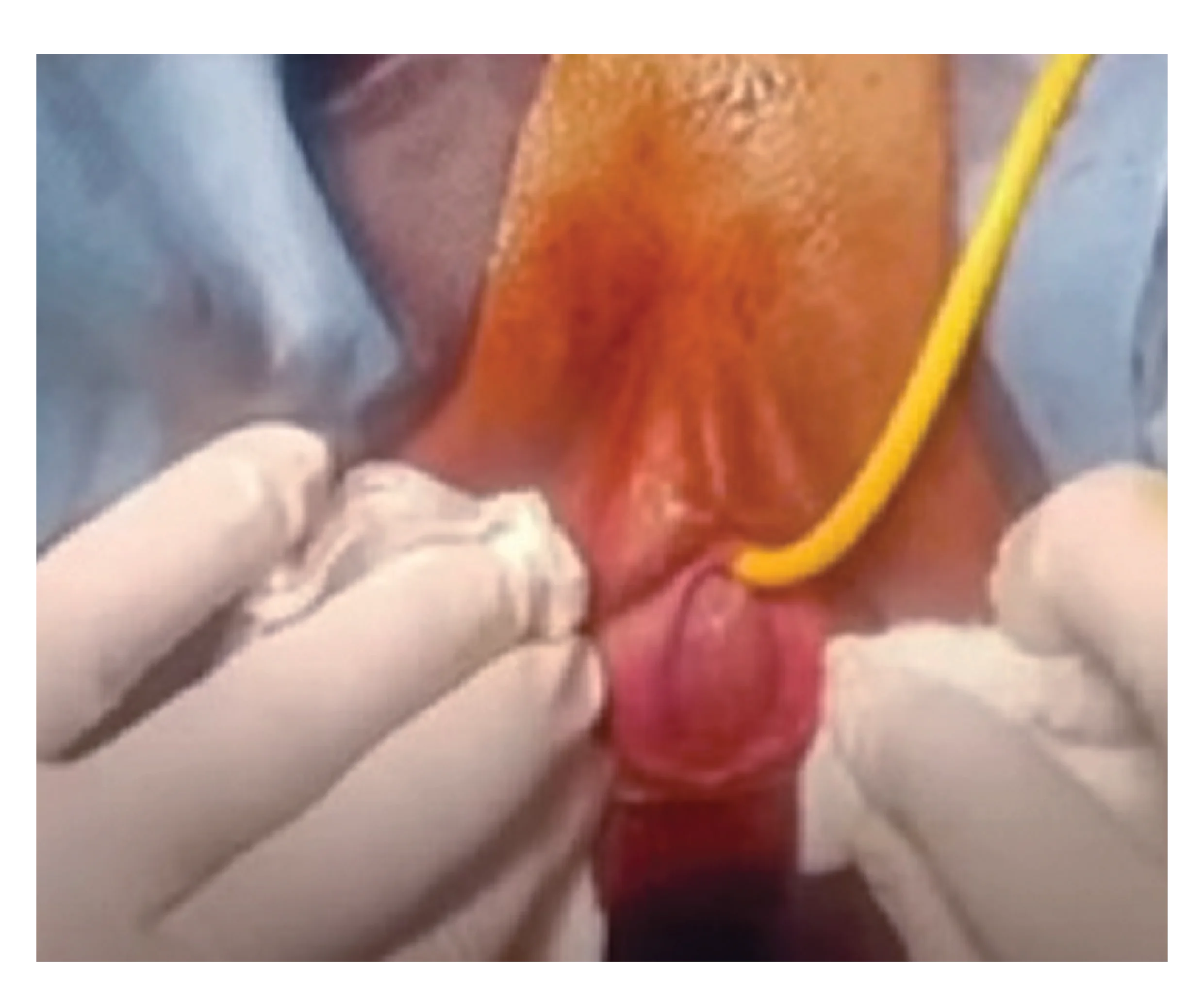
a. Imperforate hymen image
b. Bartholin cyst
c. Gartner's cyst
d. Septate uterus
Answer: Imperforate hymen image
Q. Ultrasound image of uterus shows snowstorm appearance in which of the following conditions?
a. Hydatidiform mole
b. Partial mole
c. Choriocarcinoma
d. Adenomyosis
Answer: Hydatidiform mole
Q. What is the treatment of cervical cancer stage III A?
a. Radiotherapy alone
b. Radical hysterectomy
c. Chemotherapy
d. Chemotherapy + Brachytherapy (Chemoradiation)
Answer: Chemotherapy + Brachytherapy (Chemoradiation)
Q. A 60 years old women with uterus protruding out 10cms. Which of the following is the best treatment?
a. Pessary placement
b. Abdominal hysterectomy
c. Vaginal hysterectomy with pelvic floor repair
d. Leforts partial colpoclesis
Answer: Vaginal hysterectomy with pelvic floor repair
Q. A pregnant woman at 37 weeks of gestation brought to emergency with pain abdomen and hypotension. On examination, there was abdominal tenderness, fetal parts were felt superficially and fetal heart rate was not heard. What could be the probable diagnosis?
a. Abruption
b. Rupture uterus
c. Intrauterine fetal death
d. Obstructed labor
Answer: Rupture uterus
Q. During a speculum examination of a woman in the gynecology OPD, the cervix appeared congested. On doing a PAP smear, the cervix started to bleed a bit. What could be the most probable organism to cause changes?
a. HPV
b. TB
c. HSV
d. HCV
Answer: HPV
Q. During an antenatal visit of a pregnant lady of 20 weeks, the fundal height is only 16 weeks. An USG done shows no amniotic fluid. Which abnormality is likely to be seen in the fetus?
a. Renal abnormalities
b. Anencephaly
c. Gastroschisis
d. Esophageal atresia
Answer: Renal abnormalities
Q. 24 years old primigravida at 30 weeks has BP of 160/120 mmhg. The lab workup shows increased SGPT, SGOT & LDH. Also there are low platelets. Which of the following is the most probable diagnosis?
a. Acute fatty liver of pregnancy
b. HELLP syndrome
c. Hepatitis B
d. Cholestasis of pregnancy
Answer: HELLP syndrome
Q. A woman with a prosthetic valve and on warfarin treatment for anticoagulation is now planning a pregnancy. What is the advice given to her in regard to the anticoagulation management?
a. Discontinue warfarin
b. Replace warfarin with heparin
c. No change in treatment
d. Vit K is added
Answer: Replace warfarin with heparin
Q. A 52 years old female came with 16 months of amenorrhea. What the test results you would expect would be?
a. High LH and high FSH
b. Low FSH and low LH
c. FSH low and LH within normal limits
d. High FSH and low LH
Answer: High LH and high FSH
Q. A presented with bleeding per vaginum in labor and a 'tender tense' abdomen on palpation. Her BP is 150/100. Cervical dilatation 5 cm and full effacement. Fetal heart rate is 144/min with adequate Beat to beat variability. What is the likely diagnosis?
a. Abruptio placentae
b. Placenta Accreta
c. Placenta previa
d. Vasa Previa
Answer: Abruptio placentae
Q. The patient had H/O severe heart disease and now she presented with a large fibroid. Anesthesiologists classified her as a moderate risk. What procedure is NOT to be performed?
a. Vaginal hysterectomy
b. Total abdominal hysterectomy
c. Laparoscopic hysterectomy
d. Subtotal hysterectomy
Answer: Laparoscopic hysterectomy
Q. Identify the image?

a. Trichomonas
b. Listeria
c. Pseudomonas
d. Enterobacter
Answer: Trichomonas
Q. First sign of magnesium sulphate toxicity?
a. Decrease in BP
b. Loss of deep tendon reflex
c. Breathing difficulty
d. Asystole
Answer: Loss of deep tendon reflex
Q. A 29-year-old nulliparous lady presented with endometriosis and infertility. On Laparoscopy there were severe Pelvic adhesions and the uterus had a bowel stuck to its fundus with dense adhesions. The ovaries were cystic, each around 6-8 cms in size, and were stuck to each other (Kissing ovaries) What is the next line of management?
a. GnRH analogues
b. OCPS
c. Hysterectomy with oophorectomy
d. B/I Cystectomy, Adhesiolysis Prepare for IVF
Answer: B/I Cystectomy, Adhesiolysis Prepare for IVF
Q. In the Graph of menstrual cycle, which alphabet shown is suggestive of ovulation?
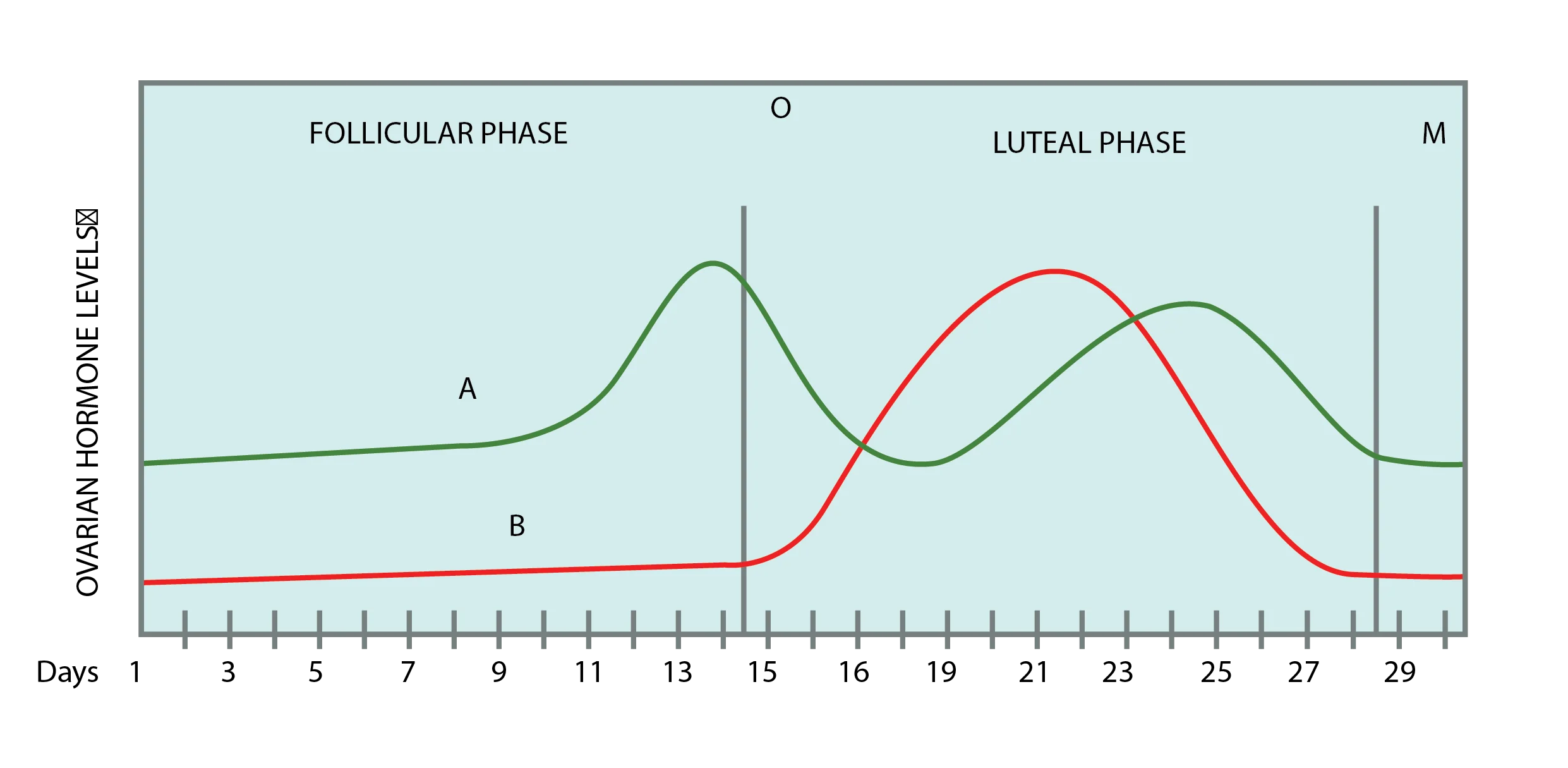
a. A
b. B
c. O
d. M
Answer: O
If you want to listen to our star faculty Dr. Prassan Vij explain all the PYQs in the simplest manner possible, check out the FMGE Flashback video below:
Q. A lady during labor presented with Persistent Occipito Posterior Position. Manual rotation was tried but it was unsuccessful. What is the pelvis type?
a. Gynaecoid
b. Anthropoid
c. Platypelloid
d. Osteomalatic pelvis
Answer: Anthropoid
Q. 32 years old unmarried women came with secondary amenorrhea. She was having regular normal-flow periods until now. Nothing was found on pelvic examination. No other associated complaints. What will you do next?
a. LH/FSH Testing
b. Estrogen level
c. USG
d. Urine HCG
Answer: Urine HCG
Q. 14 yrs old girl presents with primary amenorrhea. On examination, Secondary sexual characters are seen. There is normal vaginal development. On USG the Uterus and ovaries were seen to be normal. What is your advice to this patient?
a. Reassurance
b. UPT
c. Karyotyping
d. LH and FSH level and TSH
Answer: Reassurance
Q. A 19-year-old girl with primary amenorrhea with normal secondary sexual characteristics. On local & per rectal examination, uterus was absent.
What is the next investigation to be done?
a. USG
b. LH and FSH
c. Estradiol estimation
d. Karyotyping
Answer: USG
Q. A P2L2 patient was using IUCD as a method of contraception. After 6 months of usage, she presents with vaginal bleeding and repeated 'black-outs' (syncopal attacks) to the Emergency Room.
What is the likely cause?
a. Ectopic pregnancy
b. Recurrent abortion
c. Sepsis
d. Coagulation abnormality
Answer: Ectopic pregnancy
Q. A G2P1L1 Lady underwent LSCS in previous pregnancy for fetal distress. This time she had an uneventful vaginal birth after caesarean section (VBAC) but the placenta could not be removed completely. The cord snapped on traction but the placenta did not deliver. She also started to bleed more profusely now. What is the likely reason for this?
a. Succenturiate lobe
b. Inversion of uterus
c. Placenta accreta
d. Placenta previa
Answer: Placenta accreta
Q. A 38-year-old P3L3 woman present with severe secondary dysmenorrhea and on USG there is a uniform enlargement of uterus upto 10 cms. What is the provisional diagnosis?
a. Adenomyosis
b. PID
c. Leiomyoma
d. Endometriosis
Answer: Adenomyosis
Q. What is the common Obstetric/ gynaecological condition where this procedure is done?
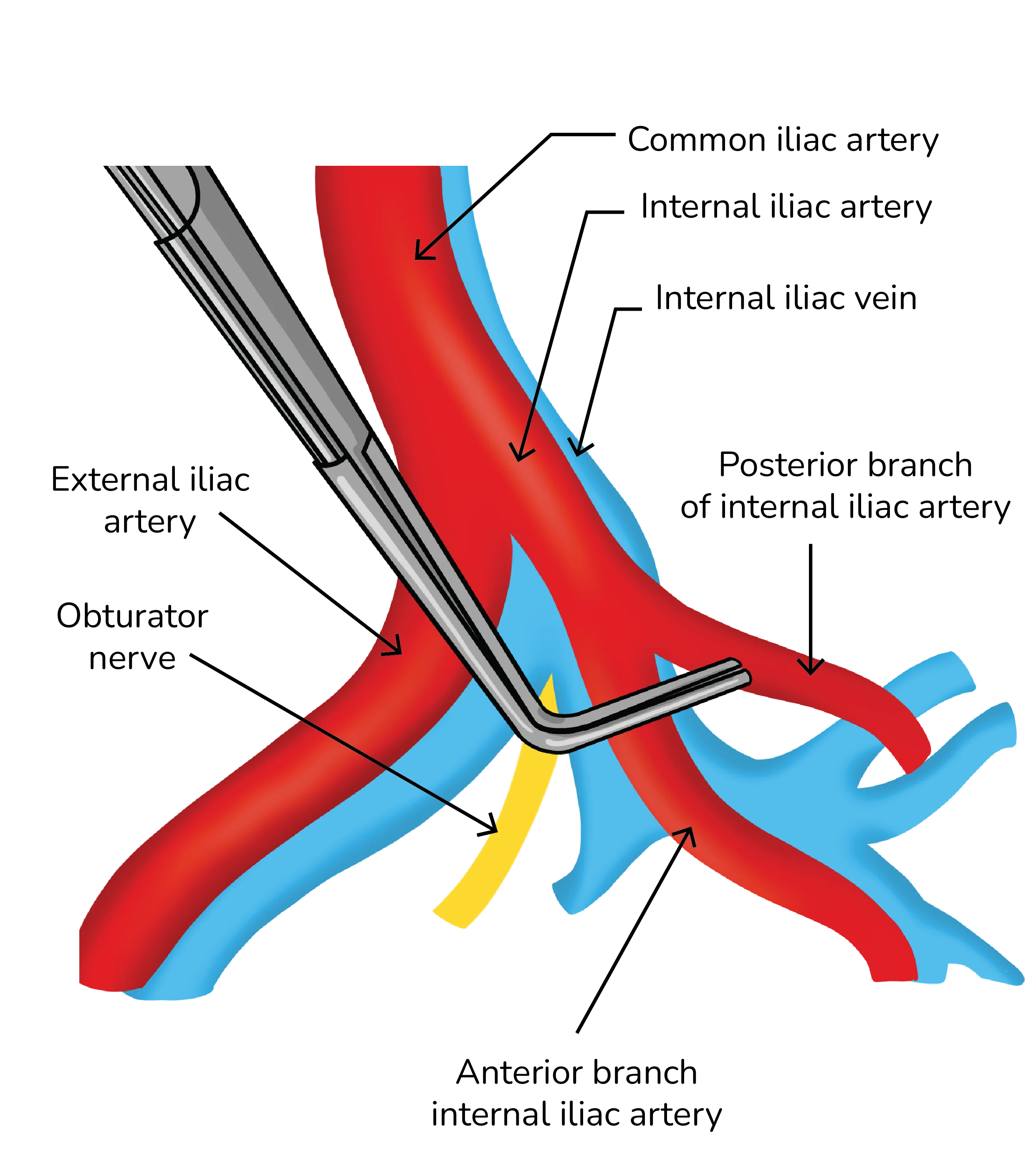
a. Dysfunctional bleed after hysterectomy
b. Atonic PPH
c. Recurrent bleed from CA cervix
d. Bleed from Ca Vulva
Answer: Atonic PPH
Q. A lady of 23 years presented to the OPD with symptoms of lower abdominal pain and Dyspareunia. On pelvic examination uterus is found to be retroverted. Also there was adnexal and cervical motion tenderness.
What could be the long-term sequelae of this condition?
a. Recurrent pregnancy loss
b. Infertility
c. Pelvic organ Prolapse
d. Amenorrhea
Answer: Infertility
Similar Question
Q. A nulliparous 29-year-old lady presents with infertility. On examination, uterus is felt to be normal size but its retroverted and fixed. Also, there is tenderness in posterior vaginal fornix. Diagnosis?
a. Adenomyosis
b. Endometriosis
c. Fibroid uterus
d. Ovarian malignancy
Answer: Endometriosis
Q. The following pelvic USG shows the ovary. What disorder/ lesion is depicted in this USG?

a. Dermoid cyst
b. Ectopic pregnancy
c. PCOD
d. Molar Pregnancy
Answer: PCOD
Q. A 30-year-old nulliparous woman presents for a routine check up when an USG reveals a unilateral ovarian cyst of size 6 x 6 cms. What is the next line of management?
a. CA 125 and follow up
b. Open oophorectomy
c. Laparoscopic cystectomy
d. Combined OCP and follow up
Answer: Laparoscopic cystectomy
While this blog only covers Most important OBG PYQs, we've also crafted an extensive post encompassing previous year FMGE question papers for the past three exams. PDFs of FMGE Previous Year Question papers are also available to help you strengthen your exam readiness.
Q. A Hysterosalpingogram of an infertile lady of 26 years showed the following results.
What is diagnosis?
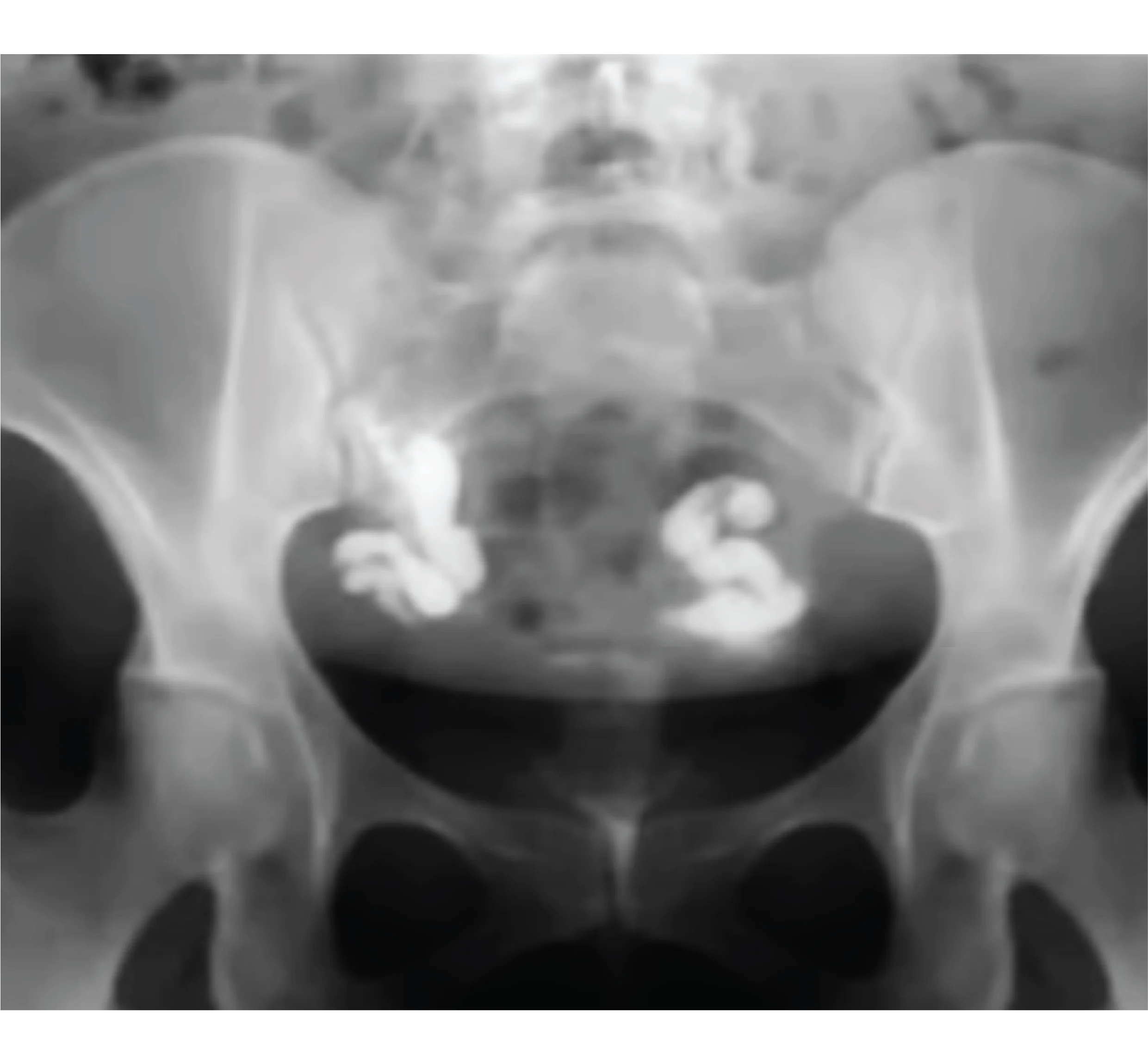
a. Hydrosalpinx
b. Reverted fixed uterus
c. Left & Right uterine fibroid
d. Cervical fibroid
Answer: Hydrosalpinx
Q. Which of the following is a contraindication to use of the contraceptive shown in image?
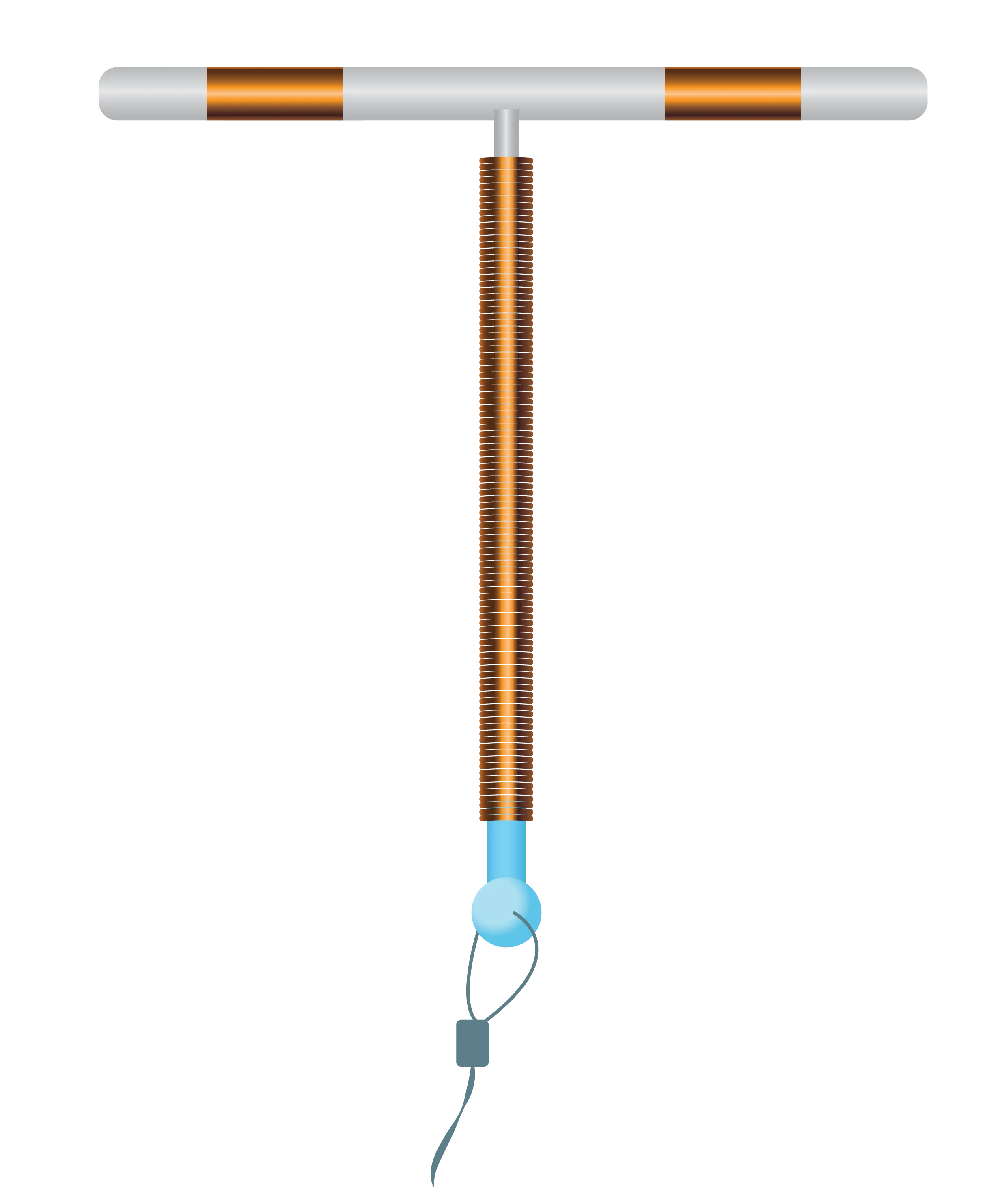
a. PID
b. Hypertension
c. Post-partum
d. Diabetes
Answer: PID
Q. A woman who is lactating came to OPD 6 weeks after delivery, for checkup and to get advice for the contraception. Which is not advised?
a. Combined OCP
b. POP
c. IUCD
d. Mini Pill
Answer: Combined OCP
Q. Which of the following is the Obstetric grip obstetrician is shown in image?
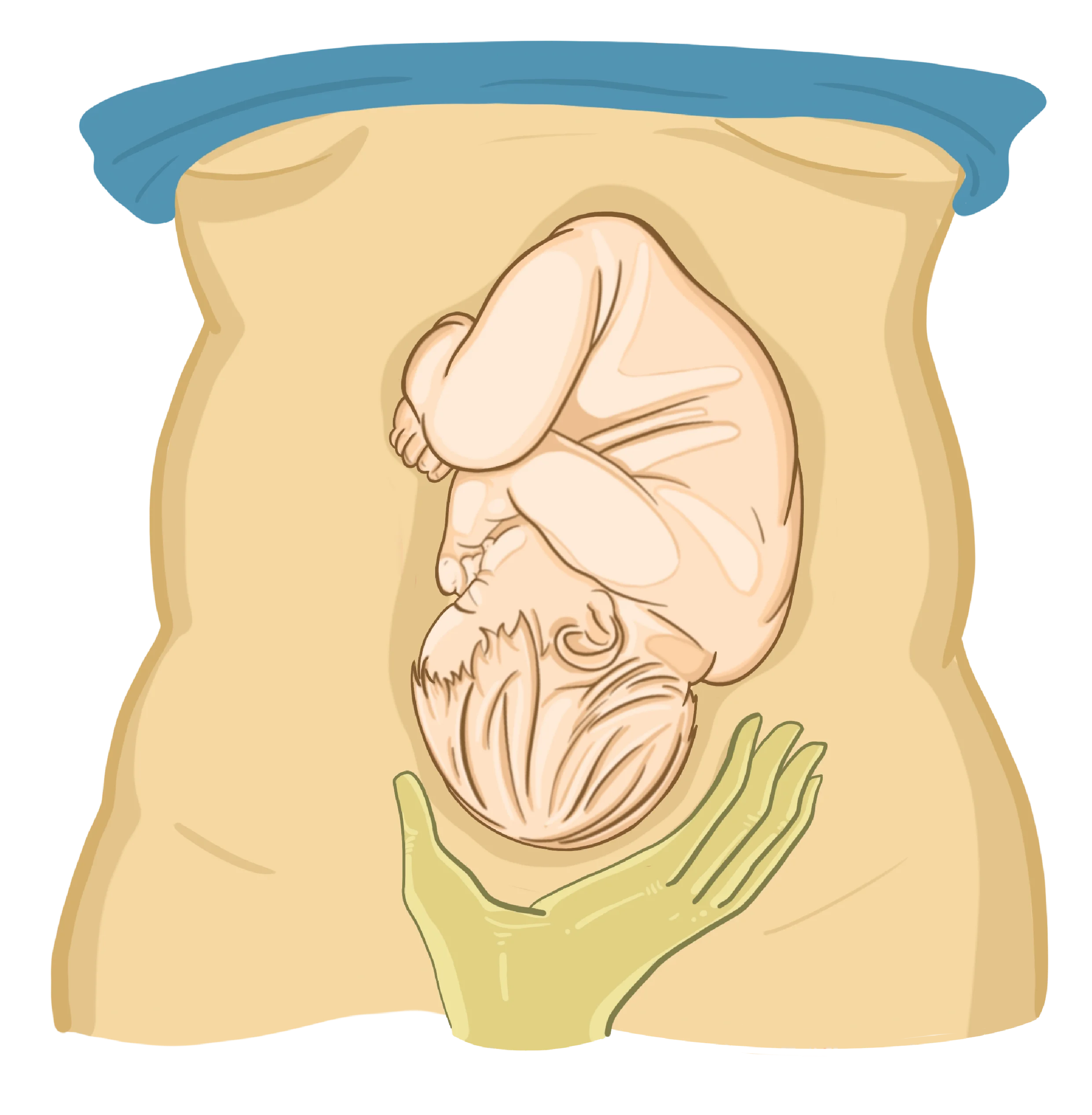
a. Grip 1
b. Grip 2
c. Grip 3
d. Grip 4
Answer: Grip 3
Q. Woman with history of abortion due to Down syndrome now she is pregnant again 11 weeks what's the BEST diagnosis modality for this child at this gestation to rule out Downs syndrome?
a. Amniocentesis
b. Chorionic Villi sampling
c. Double marker
d. Triple marker
Answer: Chorionic Villi sampling
Q. 25-yr-old married man came to infertility clinic, having azoospermia. Normal sized testis, FSH and testosterone levels also normal. What could be the reason?
a. Obstructed Vas
b. Kallmann syndrome
c. Klinefelter syndrome
d. Noonan syndrome
Answer: Obstructed Vas
Q. A woman with previous 2 abortion is undergoing the 'Dilator test' and an 8 size hegar easily passes through the cervix. What is the diagnosis??
a. Septate Uterus
b. Unicornuate uterus
c. Uterine Didelphys
d. Incompetent Cervix
Answer: Incompetent Cervix
Q. A line drawn from the mid part of the posterior surface of the symphysis pubis to the tip of the scaral promontory (in red here) is which of the following diameters of the pelvis?
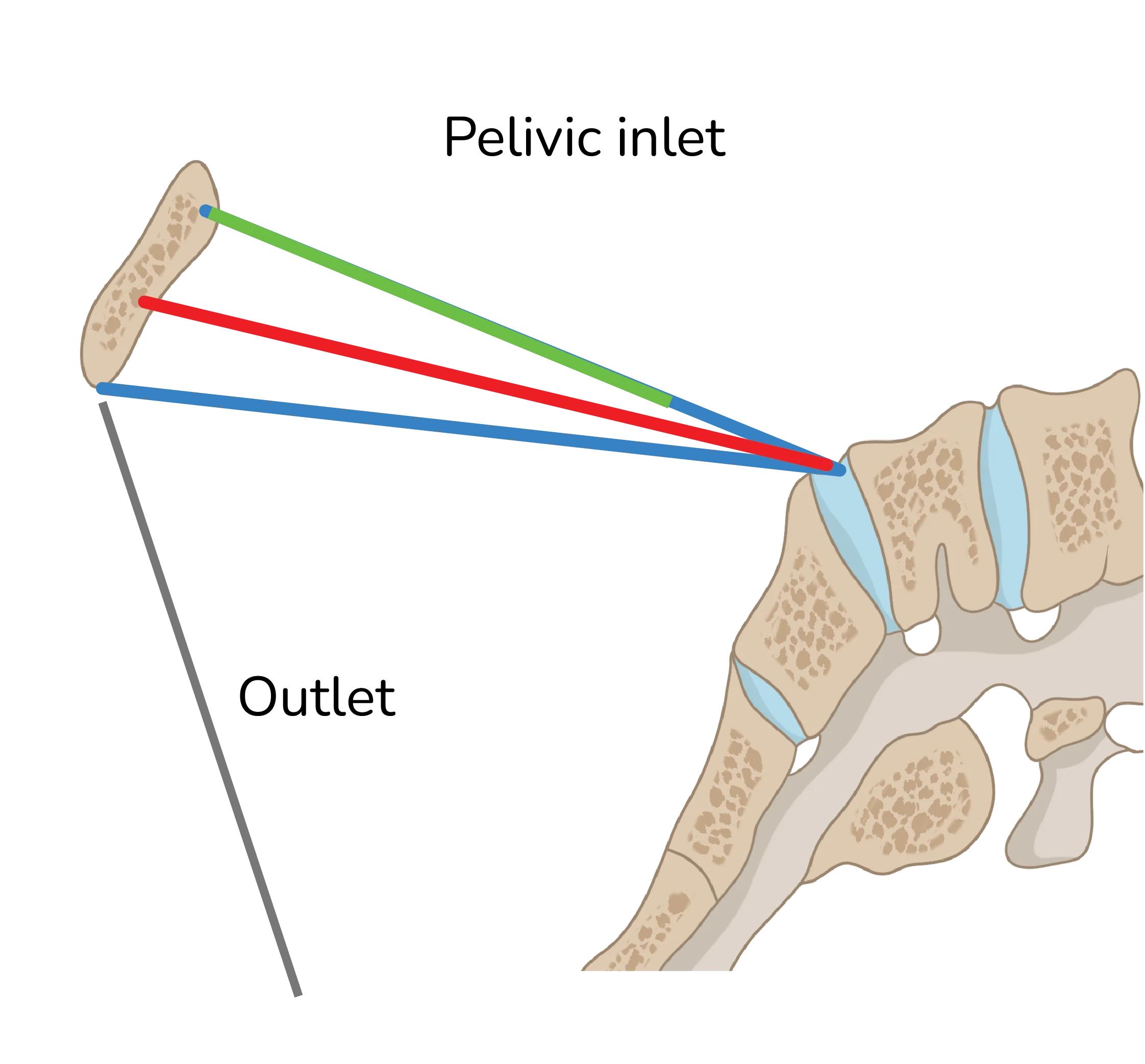
a. Anatomical (True conjugate)
b. Obstetrical conjugate
c. Diagonal conjugate
d. Interspinous diameter
Answer: Obstetrical conjugate
Q. A women presents with secondary amenorrhea. She has a history of curettage for abortion. FSH is 7 IU/L. What is the most likely diagnosis?
a. Pituitary failure
b. Ovarian failure
c. Uterine synechiae
d. Pregnancy
Answer: Uterine synechiae
Q. Which of the following does not increase the risk ectopic pregnancy?
a. History of tubal ectopic
b. Intra-Uterine Contraceptive Device use
c. History of infertility treatment
d. History of Pelvic inflammatory disease
Answer: Intra-Uterine Contraceptive Device use
Q. Which of the following is a selective estrogen receptor modulator?
a. Tamoxifen
b. Anastrozole
c. Mifepristone
d. Ethinyl estradiol
Answer: Tamoxifen
And that sums up the most important FMGE PYQs for Obstetrics and Gynaecology by our star faculty, Dr Prassan Vij.
With less than 90 days to go for the FMGE July ‘25 exam, it is time to make your PYQ preparation airtight. PYQs alone can help you crack 150+ in the FMGE July 2025.
Go through all the questions carefully. According to our star faculty for FMT, Dr Akhilesh Raj Jhamad, the exam is likely to contain 10-12 questions from Forensic Medicine and Toxicology.
All the best for your preparation.
Team PrepLadder.


Arindam Goswami
Arindam is a Content Marketer who looks after the Medical Super Specialty segment, specifically the NEET SS category, at PrepLadder. He aims to help aspirants crack exams and realize their dreams through his work.
Top searching words
The most popular search terms used by aspirants
- FMGE Preparation Tips
- FMGE revision strategy
- Gynecology OBGYN
PrepLadder Version X for FMGE
Avail 24-Hr Free Trial